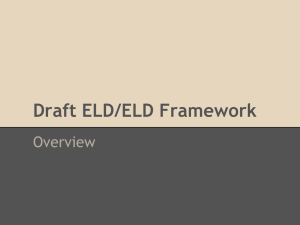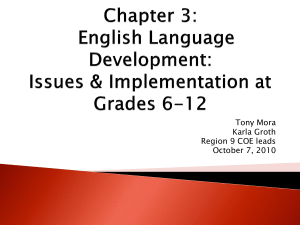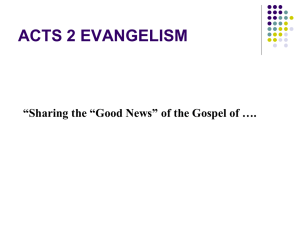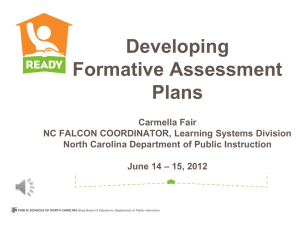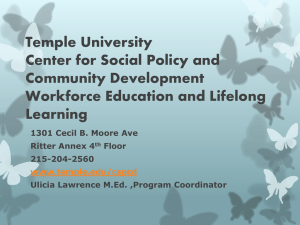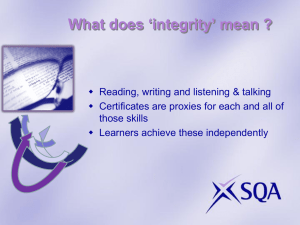Elementary English Learners
advertisement
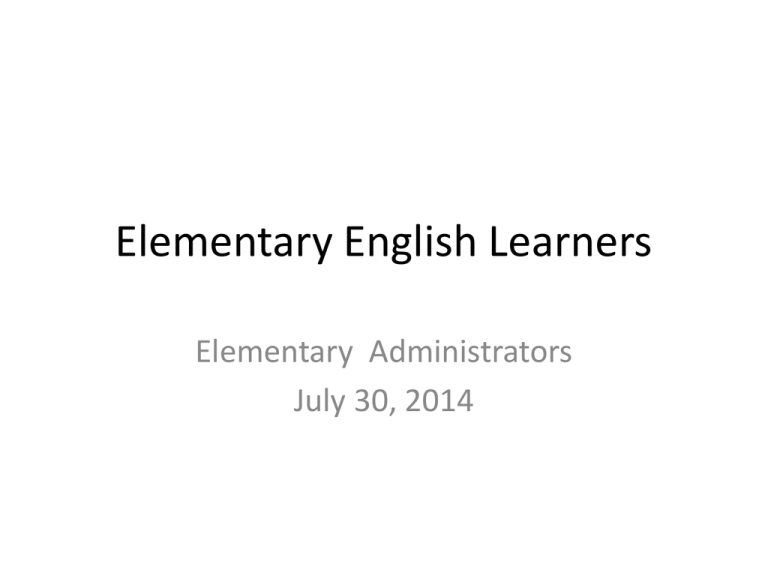
Elementary English Learners Elementary Administrators July 30, 2014 English Learners • Watch the video • Note two of the EL issues that are presented that stand http://youtu.be/s2YKNk4P out to you. -wA • Respond to the writing prompt at the end of the video Ch ch ch Changes………. Common Core Standards Staircase Result in College and Career Readiness • Based on solid research and practice evidence • Fewer, Higher and Clearer EL’s must obtain information and request clarification. El’s must construct explanations, engage in arguments. EL’s must demonstrate understanding & confirm being understood. EL’s must articulate their own ideas and build on others’ ideas. Language Demands of the Common Core Standards 6 ELA SHIFTS in Standards • • • • • • Literacy Standards for Content Areas Increased Emphasis on Informational Text Text Complexity Writing Arguments Focus on Collaborative Conversations Integration of Media Sources Special care to appropriately scaffold the journey for our EL’s so they can climb too. Key Shift in the Common Core: Language development across the curriculum • Language development occurs within a dedicated ELD curriculum (designated ELD) AND across all academic subjects (integrated ELD). Key Shift in the Common Core: Language development across the curriculum • Academic language develops in the context of learning academic subjects – students learn to talk and write about history, science, math, through a focus on the language of the academic disciplines. Key Shift in the Common Core: Language development across the curriculum • The CCSS call upon all content teachers to focus more explicitly on the discourse patterns, vocabulary and oral language essential to full participation in academic work within their disciplines. Key Shift in the Common Core: Language development across the curriculum • All teachers need an understanding of literacy and language, and the strategies to promote active engagement with language in the content classroom. 3 Instructional Shifts • Reading, writing, speaking grounded in evidence from text, both literary and informational Focus on creating opportunities and developing strategies for increasing student discourse and collaborative conversations which includes the use of daily language objectives in all EL instructional settings. • Regular practice with complex text and its academic language. • Building knowledge through content rich non fiction. Targeted academic vocabulary instruction and strategies to enable access to complex text In addition………. • CA ELD Standards • Local Control Funding Formula • Publishers racing to create materials that are aligned to the new Common Core and CA ELD Standards • SBAC WCCUSD Support for Elementary EL Programs Rebuilt Master Plan for English Learners Elementary teachers were trained in Treasures ELD in tandem with Treasures/Tesoros RLA Monthly TBE/DLI Support Meetings 3 Levels of ELD PD/Coaching Series using Treasures ELD Coaching Support at Focus Schools CA 2012 ELD Standards Overview Brokers of Expertise WCCUSD English Learner Master Plan • • • • • • Components Identification, Assessment and Program Placement Instructional Programs Monitoring of Student Progress and Reclassification Parent and Community Involvement Evaluation and Accountability Appendix with Legal References and Glossary Still work to do……… • EL Master Plan goes to board in August • Plan will be implemented in phases • Introduction to WCCUSD staff and community will occur at various meetings and events throughout the school year. • Operations manuals for Registration, Assessment and Placement (RAP) and EL Program to be published later this year. Educators have a Dual Obligation to English Learners • Provide meaningful access to grade-level academic content via appropriate instruction (Integrated ELD) • Develop students’ academic English language proficiency (Designated ELD) Interconnected, not separate! Simultaneous, not sequential! So what will help our teachers? • 2012 ELD Standards • Sustained collaboration and professional learning around key problems of practice • Deep understanding of disciplinary literacy (content AND language knowledge) • Formative assessments within teaching and learning Why establish ELD standards? • English learners at all English language proficiency levels are capable of engaging in intellectually rich instruction in all content areas. • English learners bring primary language resources that should be valued in their own right and used as a resource for learning English. • English learners learn both language and content through meaningful interactions with others and by learning about how language works to make meaning. ELD Shifts: New ELD Standards • Adopted on November 7, 2012 by SBE • Correlated to CCSS & designed to help ELs build critical knowledge and skills • Describe key knowledge, skills, and abilities in core areas of ELD http://www.cde.ca.gov/sp/el/er/eldstandards.asp California Implementation Timeline So Far… 2010 August SBE Adopts Common Core State Standards 2011 October AB124 Mandates Revision of ELD Standards Right Now 2012 November SBE Adopts ELD Standards 2014 June (anticipated) ELD Standards to be reformatted and aligned to New Generation Content Standards. 2013 December ELA/ELD Curriculum Framework developed for public review. Next….. 20152016 Developm ent of new ELPAC assessme nt What’s on the Horizon . • 2015-16—ELP Assessments for California (ELPAC) • 2016—ELA/ELD K-8 Instructional Materials Adoption . EL K-12 Standards Support Plan for 2014-15 • Various Professional Development Series on the CA ELD Standards and Implementing Treasures ELD. • Monthly Sheltered or SDAIE Support meetings (new), in addition to monthly ELD meetings (new). Continue with monthly TBE/DLI Support meetings. • Expansion of ELD Coaching (additional coaches) and TBE/DLI Coaching (new). • Centrally funded GLAD training for elementary and secondary teachers. Let’s take a look at the CA ELD Standards…………. Amplify critical knowledge about English language skills in the CCSS for ELA/Literacy that English learners need to be successful in school To be used by content area teachers as well as ELD teachers to ensure support for our EL students. Proficiency Level Descriptors Include: • Overall Proficiency (entry & exit) • Extent of linguistic support needed • Describe knowledge, skills, and abilities across a continuum • Three levels: Emerging, Expanding, Bridging at early and exit stages • Guide targeted instruction in ELD and differentiated instruction in content areas ELD Standards • Amplify ELA Standards • Organized by grade level • Divided into 3 parts • • • Interacting in Meaningful Ways Learning About how English Works Using Foundational Literacy Skills Look at Standards Standards Walk • Work with a partner at your table • Pick one grade level ELD standard • Read the emerging description • Read the expanding description of the same standard – highlight what you see has been added in comparison with the emerging description. • Now read the bridging description of the same standard – highlight what you see has been added in comparison with the expanding description. • Be prepared to share what you saw with the rest of the group. What should we see in the classrooms? ELD Language objective Academic vocabulary Focus on language structures and functions Opportunities for oral practice Collaborative Conversations Visual Cues Graphic Organizers Sheltered Content and related language objective Academic vocabulary Focus on language structures and functions Opportunities for oral practice Collaborative conversations Visual Cues Graphic Organizers Points to Consider What tasks do I want my students to be able to complete independently? •Determine the central ideas from various texts and summarize accurately (7th Grade History Literacy 2.0) •Explain ideas based on close readings of grade-level texts (7th Grade ELD – Writing 6-A) What do I need to consider getting them to that point? •The academic language they need to be successful •Their language needs according to their PLD (emerging, expanding, bridging) •How to make our time together relevant, challenging, and engaging What tools do I have to put all of this together for my students? •Scaffolding •Differentiation •Integrated instruction Ah-ha! If I integrate the academic content and ELD standards, my students will develop both the academic and English fluency. I am the best teacher ever! Integrated and Designated ELD: Working in Tandem Integrated ELD: All teachers with English learners in their classrooms use the CA ELD Standards in tandem with the CA CCSS for ELA/Literacy and other content standards. Designated ELD: A protected time where teachers use the CA ELD Standards as the focal standards in ways that build into and from content instruction. What should we see EL students doing in ELD and Sheltered/SDAIE classrooms? • Engaging in productive oral discourse and written group work with peers that incorporates academic vocabulary tied to the lesson or unit of study. • Participating in effective oral discourse and written communication with teachers. • Explaining and demonstrating their knowledge using emerging complex language, academic vocabulary and other communicative strategies in different settings. • Extracting meaning from complex written texts. What should we see in the classrooms? ELD Language objective Academic vocabulary Focus on language structures and functions Opportunities for oral practice Collaborative Conversations Visual Cues Graphic Organizers Sheltered Content and related language objective Academic vocabulary Focus on language structures and functions Opportunities for oral practice Collaborative conversations Visual Cues Graphic Organizers We must ensure daily, high quality ELD instruction for our EL students • Administrators have to know what to look for in ELD • Daily language objectives that frame opportunities for discourse and collaborative conversations using academic language. • Using genuine formative assessments to guide instruction frequently. • Get to the classrooms regularly to ensure it happens • Ensure that ELD teachers have opportunities for feedback on their instruction and time to collaborate with one another. Let’s Practice - ELD • Pick a partner at your table • Read the ELD vignette • Work together to highlight examples in the vignette that illustrate teacher and student behaviors that are listed in your packet • Discuss with your partner how you would structure teacher feedback based on this vignette • Be ready to share out Designated ELD Vignette Snapshot 3: Designated ELD Connected to Mathematics In mathematics, Mrs. Cooper teaches her students to solve word problems and how to explain their thinking and justify their arguments for solving a problem a particular way. She models how to solve word problems and thinks aloud for students as she does, using drawing and other visuals to make their thinking process visible. She models how to identify language that reveals what kind of word problem she is solving (e.g., how many are left, how many are there altogether, how many more), how to identify the important information for Solving the problem, and how to apply math content knowledge to solve the problems. She provides many opportunities for her students to practice by Collaboratively solving word problems with peers and explaining how they solved the problems, using their drawing and writing to justify their assertions. Let’s practice – ELD http://www.myboe.org/cognoti/content/file/c ontent/repository/509621/11/1159f851/1159 f851cdb67d308c19c321e09b9d3958c7210e// Popups//U3Learn4.html
